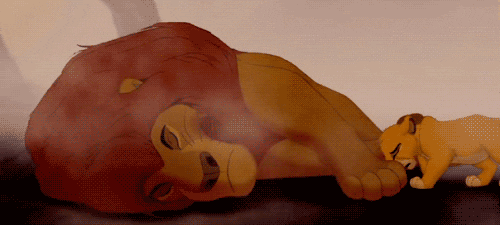

Mirror Neurons: Empathy, Imitation & Irrationality in Marketing
🧠 Imitation is the sincerest form of irrational decision-making
How many of you look at this image and get an immediate urge to yawn?
How about looking at the following image and immediately feel a sense of sadness?
Does the following man releasing his hand make you nervous?
These are natural reactions.
But – in many ways, they make absolutely no sense.
Why do we get an urge to yawn, even if it’s not morning or we’re not explicitly tired?
Why do we feel a sense of deep loss or even the impulse for tears when we see Simba in a tragic situation, even if we’ve never experienced a loss of a loved one?
Related Content: Can You Use Fear in Marketing to Increase Sales?
Why do we feel the plunging anxiety of hanging off a building even as we’re comfortably sitting in a desk chair?
It all comes down to two words that have changed the landscape of neuroscience and marketing for over 30 years: Mirror Neurons.
What are Mirror Neurons?
In 1992, Italian scientist Giacomo Rizzolatti and his team were studying the brains of monkeys to understand motor behaviors. Specifically, they were researching the premotor region of the brain, that registers activity when monkeys carry out certain gestures like moving and picking up objects.
One day, there was a twist.
Martin Lindstrom covers the discovery in his book, Buyology:
On one particularly hot summer afternoon, Rizzolatti and his team observed the strangest thing of all when one of Dr. Rizzolatti’s grad students returned to the lab after lunch holding an ice cream cone, and noticed that the macaque was staring at him, almost longingly. And as the grad student raised the cone to his mouth and took a tentative lick, the electronic monitor hooked up to the macaque’s premotor region fired—bripp, bripp, bripp.
The monkey was just sitting there. It hadn’t moved. It hadn’t even touched an ice cream cone.
Simply observing someone licking an ice cream cone prompted the monkey’s brain to mentally imitate the very same gesture, otherwise now known as the activation of a mirror neuron.
Simply put, mirror neurons are neurons that fire when an action is being performed and when that same action is being observed. We know they work in monkeys and there is considerable evidence over the years that they work in humans as well.
Think back to the above prompts: Do you wonder why you yawn? Why you well up in tears? Why you feel a sense of anxiety when observing someone else in a precarious situations? Chalk it up to mirror neurons.
It gets crazier: Mirror Neurons are not only active when we see people performing certain actions but they can even get fired when we’re reading about someone performing it.
Imagine that I’m yawning right now. Just letting out a giant yawn. Embracing a reflex consisting of the simultaneous inhalation of air and the stretching of the eardrums, followed by an exhalation of breath. Also known as a yawn.
Are you yawning now? or even remotely tempted to yawn?
Not because you’re bored but simply because I typed the word yawn.
Why are Mirror Neurons important to Marketers?
So at the end of the day, what value does this provide to marketers?
Mirror neuronscan often override consumer rational thinking and cause people to want to unconsciously imitate – and use – what its in front of them.
This concept of imitation is a huge factor in why we buy the things we do.
Imagine walking into a department store and seeing a perfect mannequin. Without even looking at the price of the clothing, you’re immediately seeing how you would look in it.
Imagine walking specifically into Abercrombie and Fitch and seeing the models playfully interacting on the walls – now you’re suddenly tempted to buy $12 boxer shorts just to get that similar feeling of bliss.
Do you recall the Apple ads for the Ipod? The silhouettes dancing with white headphones?
All mirror neurons tempting you to find the joy in dance.
Think about every GIF you’ve seen in an email.
You see someone comfortably sitting in a chair, by a fire – and before you know it, you’re imagining yourself stylish, warm, and comfortable.
Before we even knew what mirror neurons were, we likely had been using similar psychology to get people to buy things like cigarettes – here’s an ad from the 1960s for a cigarette with a simple premise: You’ll have love, laughter, and joy from Viceroy. People bought it by the hordes.
Tips for marketers thinking through mirror neurons and imitation: Consider your audience.
How much can they empathize with the emotional pull in your content?
How valuable will your product be after 2-3 months once the emotional pull is gone?
Think back to Abercrombie – while you’re in the store with its rugged scent and playful models, how valuable is that purchase going to be six months down the road?
The mirror neurons might work once – but eventually they will be replaced by rational evidence that this product is not enduring enough to last through the initial imitation.
This is a repost from my friend and fellow marketing psychology lover, Kushaan Shah. Subscribe to his awesome newsletter, The Marketing Mind Meld, if you want more smart content like this gift-wrapped and sent straight to your inbox.
Want to talk about sales and marketing psychology? Add me on LinkedIn or tweet me! (I also have a newsletter if you’re interested!)







